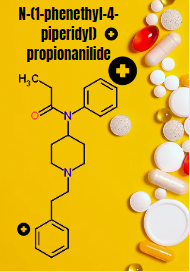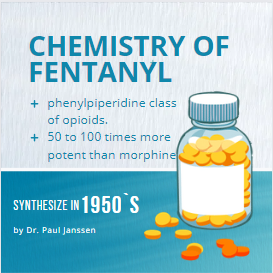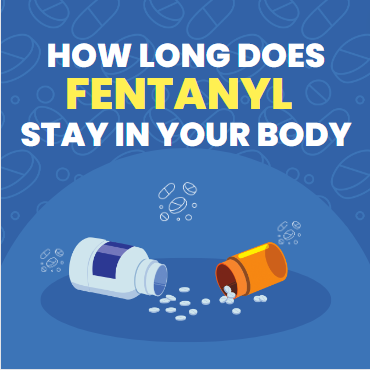
Hi!! Apart from fun learning facts about phenol crystals, ketone perfumes and alcohol markers, do you know what Fentanyl is? and how long does fentanyl stay in your system? lets have a look.
Fentanyl, a synthetic opioid, is widely known for its potency and effectiveness in managing severe pain. Its chemical structure, N-(1-phenethyl-4-piperidyl) propionanilide, is crucial to its analgesic properties. This structure enables Fentanyl to bind strongly to opioid receptors in the spinal cord and brain, exerting its powerful pain-relieving effects.
Chemistry of Fentanyl.
Fentanyl belongs to the phenylpiperidine class of opioids. Its molecular structure consists of a phenethylamine core with an attached piperidine ring. This structure is responsible for its high potency and rapid onset of action, making it approximately 50-100 times more efficient than morphine. Fentanyl’s potency also contributes to its high risk of overdose and potential for addiction.

History of Fentanyl.
Fentanyl’s history as a drug dates back to its synthesis in the 1950s by Dr. Paul Janssen, a Belgian chemist. Initially developed as a synthetic opioid for medical use, Fentanyl was primarily used as an intravenous anaesthetic during surgeries and medical procedures due to its potent analgesic properties and rapid onset of action.
Over time, pharmaceutical companies began to produce various formulations of Fentanyl for medical purposes, including transdermal patches, lozenges, nasal sprays, and injectable solutions. These formulations provided alternative methods of delivering Fentanyl for pain management, especially for patients with chronic pain conditions.
Fentanyl Misuse In U.S.
However, the misuse of Fentanyl as a recreational drug emerged in the late 1970s and early 1980s. Illegal fentanyl production became more prevalent, leading to its distribution on the black market. Individuals seeking euphoria and pain relief began to abuse Fentanyl by smoking, snorting, or injecting it.

The misuse of Fentanyl escalated in the 21st century, contributing to a rush in opioid-related overdose deaths and addiction cases. Unlawful manufactured Fentanyl, often combined with other drugs such as heroin or cocaine, became a major concern for public health authorities worldwide. The efficiency of Fentanyl and its equivalents significantly increased the risk of overdose and death among users.
Recently, Fentanyl intake has escalated in the USA, with almost 67,000 deaths occurring due to opioid misuse. Among them, approximately 70% of deaths occur due to Fentanyl.
Metabolism of Fentanyl.
Let us understand how Fentanyl is metabolized. Once ingested, Fentanyl undergoes hepatic metabolism primarily by the cytochrome P450 enzyme system, specifically the CYP3A4 enzyme. This metabolism produces several metabolites, including norfentanyl, which are eventually excreted from the body. The elimination of Fentanyl is relatively short, typically ranging from 2 to 4 hours. However, the duration of Fentanyl’s effects and its detectability in the body can vary based on factors such as dosage, frequency of use, and individual metabolism.
How Many Days Does Fentanyl Stay in Your System?
The duration that Fentanyl stays in your system depends on the route of administration and individual factors. For example:
- Fentanyl Patch: Transdermal fentanyl patches, commonly used for chronic pain management, can continue to release Fentanyl into the bloodstream for up to 72 hours after application. The answer about how long does fentanyl patch stay in your system is here. The traces of the drug can still be detected in the body for several days after the patch is removed.
- Smoked Fentanyl: The effect of Fentanyl is rapid once smoked, but it also has a shorter duration of action compared to other routes of administration. However, traces of Fentanyl can still be detected in urine for up to 2-4 days after use.
What Does Fentanyl Show Up On A Drug Test?
Fentanyl is often include in standard drug screenings, and specialized tests can distinguish between Fentanyl and its metabolites. These tests can detect fentanyl use even at low doses and are commonly use in workplace drug testing and forensic investigations.
During the metabolism of Fentanyl, several metabolites are produce, including norfentanyl. These metabolites can also be detect in drug tests, contributing to the accurate identification of fentanyl use. Specialized urine tests can detect fentanyl metabolites, providing valuable information for medical and forensic purposes.
1. Fentanyl Detection in Urine.
Urine test is one of the most common methods used to detect fentanyl use. The presence of Fentanyl and its metabolites in urine can indicate recent use or exposure to the drug. The detection window for Fentanyl in urine typically ranges from 1 to 4 days after the last use. However, this can vary depending on factors such as the sensitivity of the testing method and the amount of drug consumed.
2. Fentanyl Detection in Blood and Saliva.
Blood and saliva tests can also be used to detect fentanyl use, although the detection window is shorter compared to urine testing. Fentanyl can be detect in blood and saliva for up to 12-24 hours after use, making these methods suitable for detecting recent drug use or exposure.
How To Get Fentanyl Out of Your System?
If you’re facing a drug test or seeking to rid your body of Fentanyl, there are no foolproof methods to speed up the elimination process. However, staying hydrated and leading a healthy lifestyle may support your body’s natural detoxification mechanisms.
Long-Term Side Effects of Fentanyl.
Misuse of Fentanyl can have devastating consequences, both for individuals and communities. The opioid epidemic, worked in part by the widespread availability of Fentanyl, has led to a flood in overdose deaths and addiction cases across the globe. Understanding the pharmacokinetics of Fentanyl and its detection in various bodily fluids is crucial for addressing this public health crisis effectively.
Fentanyl’s potency and rapid onset of action make it highly dangerous, especially when used recreationally or without medical supervision. It can cause respiratory depression, coma, and death, particularly when taken in high doses or combined with other central nervous system depressants like alcohol or benzodiazepines.

Fentanyl and Workplace Drug Testing.
In many workplaces, drug testing is a routine practice, especially in safety-sensitive industries. Fentanyl is often includes in standard drug panels due to its widespread use and potential for abuse. Employers may use urine, blood, or saliva tests to detect Fentanyl and its metabolites, ensuring a safe and drug-free work environment.
Conclusion.
In conclusion, Fentanyl is a potent opioid with a relatively short duration of action but a long detection window in the body. Understanding how long Fentanyl stays in your system is crucial for both medical and forensic purposes. Effective drug testing methods, including urine, blood, and saliva testing, play a vital role in detecting fentanyl use and addressing the challenges posed by opioid misuse and addiction. Education, prevention, and access to treatment are essential components of a comprehensive approach to combating the opioid epidemic and ensuring the health and well-being of individuals and communities.
FAQs About Fentanyl.
1. Does Fentanyl make you sweat?
Yes, sweating can be a side effect of fentanyl use. Fentanyl, like other opioids, can affect the body’s autonomic nervous system, leading to changes in body temperature regulation. Sweating may occur as a result of Fentanyl’s impact on the hypothalamus, which controls temperature regulation.
2. How long does Fentanyl take to work?
The onset of Fentanyl’s effects varies depending on the route of administration. Intravenous (IV) administration typically results in rapid onset, with effects felt within minutes. Transdermal patches, on the other hand, release Fentanyl slowly over time, with pain relief occurring gradually over several hours.
3. How long does fentanyl IV last?
The duration of Fentanyl’s effects administered intravenously depends on factors such as dosage and individual metabolism. Generally, the analgesic effects of IV Fentanyl can last for approximately 30 to 60 minutes.
4. How much Fentanyl is dangerous?
The lethal dose of Fentanyl varies among individuals and depends on factors such as tolerance, previous opioid use, and simultaneous use of other substances. However, Fentanyl is extremely efficient, and even small amounts can be dangerous or fatal. Ingesting or using Fentanyl without medical supervision is highly risky and can lead to overdose and death.
5. Is Fentanyl an anesthesia?
Fentanyl is commonly used as an analgesic (pain reliever) in anaesthesia. It is often administer alongside other anaesthetic agents to induce and maintain anaesthesia during surgical procedures. Fentanyl’s rapid onset and short duration of action make it suitable for use in anaesthesia.
6. Can Fentanyl be absorbed through the skin?
Yes, Fentanyl can be absorb through the skin, particularly when administered via transdermal patches. These patches deliver Fentanyl through the skin and into the bloodstream over an extended period. However, proper use and disposal of fentanyl patches are essential to prevent accidental exposure and overdose.
7. How long does it take to die from Fentanyl?
The time it takes to die from fentanyl overdose varies depending on factors such as the amount of Fentanyl consumed, the individual’s tolerance to opioids, and the presence of other drugs or substances. In some cases, death can occur rapidly, within minutes to hours after ingestion or administration.
8. Do people take Fentanyl on purpose?
Yes, some individuals intentionally misuse Fentanyl for its potent analgesic and euphoric effects. Recreational use of Fentanyl, whether by smoking, snorting, or injecting, is a significant concern due to the drug’s high potency and risk of overdose.
9. How to pass a fentanyl drug test?
There is no guaranteed method to pass a fentanyl drug test if the drug has been used. Fentanyl and its metabolites can be detected in various bodily fluids, including urine, blood, and saliva, using specialized testing methods. The best way to avoid a positive drug test is to abstain from using Fentanyl altogether.
10. What can cause a false positive for Fentanyl?
Several medications and substances can potentially cause a false positive result for Fentanyl in drug tests. These include certain antidepressants, antipsychotics, and over-the-counter medications containing tramadol or diphenhydramine. However, confirmatory testing can help distinguish true positives from false positives.
11. How fast can Fentanyl kill you?
The speed at which Fentanyl can kill varies depending on factors such as dosage, route of administration, and individual tolerance. In some cases, respiratory depression and overdose can lead to death within minutes to hours after fentanyl ingestion or administration
